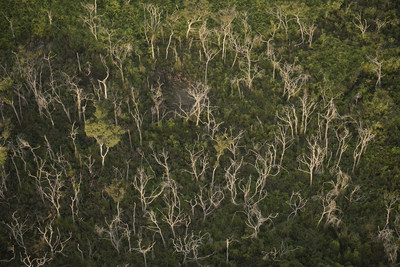FALMOUTH, Mass., Dec. 3, 2015 ” The fate of tropical forests will again be a topic of this week’s UNFCCC 21st Conference of the Parties (COP21) negotiations in Paris. This time, however, the discussion of tropical forests takes on even more importance because scientists are now able to estimate forest carbon content and CO2 emissions with a much greater degree of accuracy.
A new paper led by Woods Hole Research Center (WHRC) Senior Scientist Scott Goetz, published today in Environmental Research Letters – Reviews, presents the capabilities that currently and will soon exist to measure, monitor and verify the carbon stock of tropical forests to meet the needs required by the UN REDD+ program. REDD+ is a mechanism for financial reward for developing countries’ verified efforts to reduce emissions from deforestation and forest degradation, while also ensuring safeguards on livelihoods and preserving biodiversity. Dr. Goetz and his co-authors explain that “for all REDD+ measurement needs, capabilities have rapidly advanced as a result of new technology as well as advances in capacity building both within and outside the tropical forest nations on which REDD+ is primarily focused.”
The paper presents an overview of the current state of the capabilities to monitor deforestation, forest degradation and carbon stock changes, all of which are requirements for meeting REDD+ objectives. According to co-author Prof. Matthew Hansen of the University of Maryland, “this study lays out all options for REDD+ monitoring, from what we can do now operationally to capabilities in the near future. It is an important and timely synthesis of the state of carbon emissions monitoring using earth observation data.”
Because REDD+ is based on payment-for-performance, the measurements must be timely and accurate, thus forest landscapes must be repeatedly measured and monitored using satellite and aircraft remote sensing combined with field measurements and forest inventories. “REDD+ programs rely on the ability to measure emissions from deforestation confidently over large scales and long time periods,” said co-author Dr. Jonah Busch of the Center for Global Development. “That wasn’t possible when climate diplomats excluded tropical forests from the Kyoto Protocol, but it’s possible now and it’s time to implement REDD+.”
Current technologies allow scientists to measure and map the past and current extent of global forests and thus to calculate greenhouse gas emission estimates. But soon new technologies, including a LiDAR instrument on the International Space Station, will allow much higher resolution and more accurate carbon stock mapping and change monitoring across tropical (and temperate) forests than is currently possible. “When combined with current data streams and other new missions under development, the way we monitor tropical forests will be revolutionized,” said Dr. Goetz. “It will also allow us to better assess forest growth and recovery, monitor safeguards for the conservation of natural forests, the biodiversity they support, and inform law enforcement and deforestation alert systems.”


